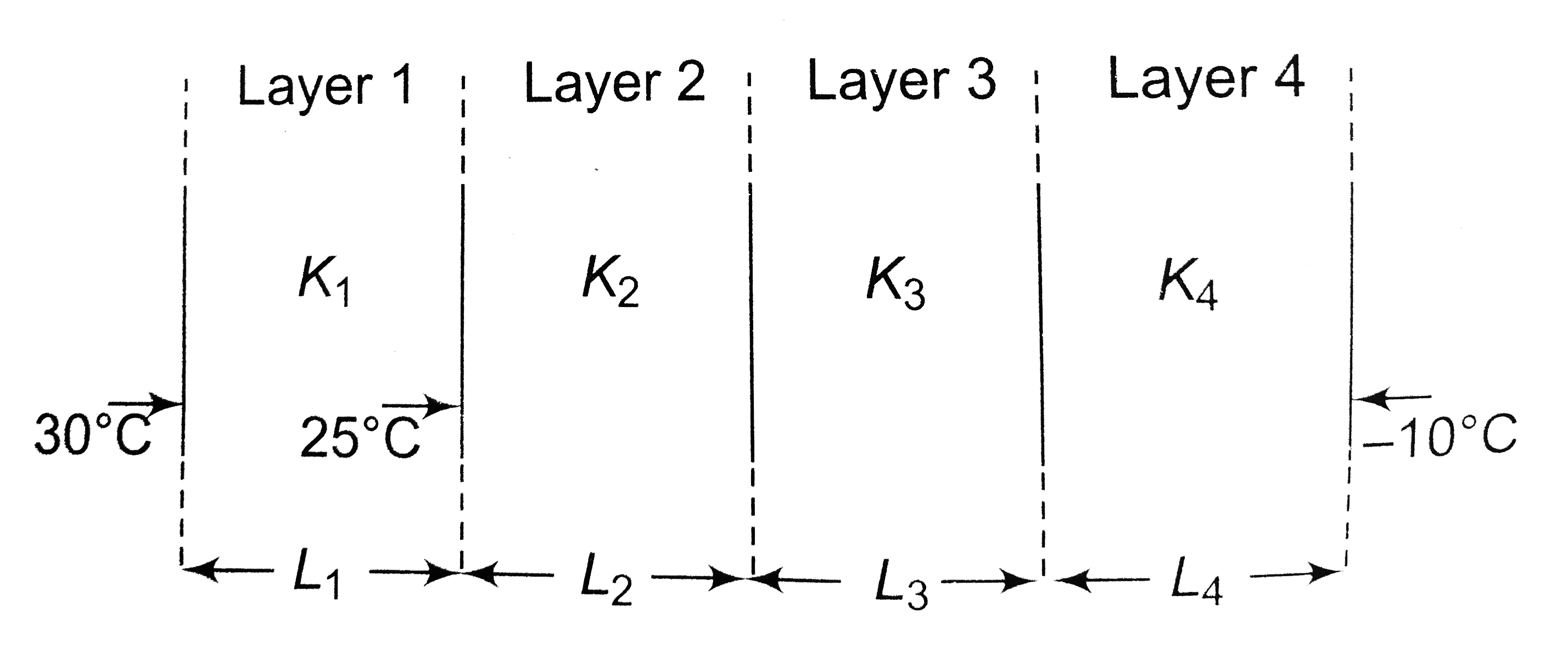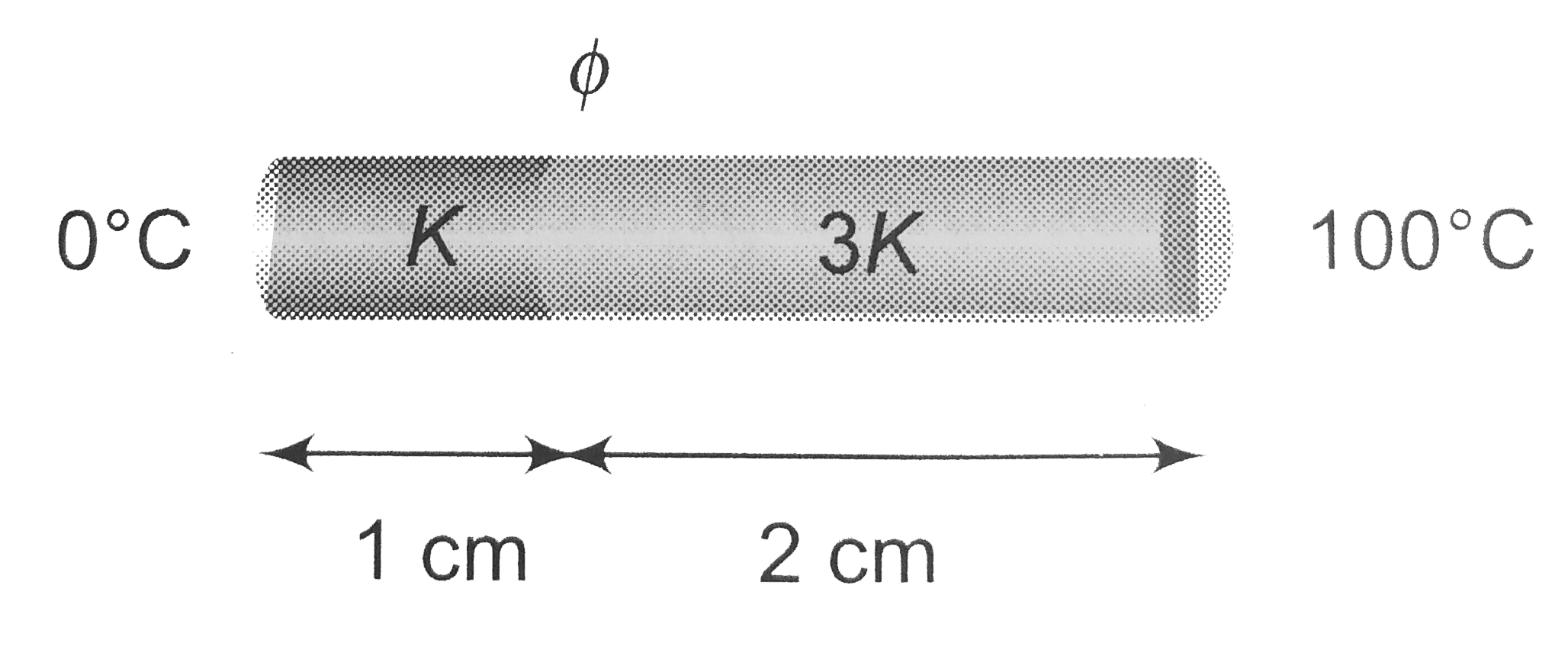
Figure shows in cros section a wall consisting of four layers with thermal conductivities K1=0.06W/mK
K3=0.04W/mK and K4=0.10W/mK. The layer thicknesses are L1=1.5cm,L3=2.8 cm and L4=3.5cm the temperature of interfaces is as shown in figure. energy transfer through the wall is in steady state.
Q. The temperature of the inteface between layers 2 and 3 is
11∘C
8∘C
7.2∘C
5.4∘C
△Q△t∣∣∣layer 1 = △Q△t∣∣∣layer 3
⇒0.06×A×51.5×10−2=0.04×A×△T2.8×10−2⇒DT=14∘C
T3=(−3+14)∘C=11∘C
Topper's Solved these Questions
Similar Questions
Figure shows ( in cross section ) a wall consisting of four layers, with thermal conductivities k1=0.060W/m.K,k3=0.040W/m.K, and k4=0.12W/m.K(k2 is not known). The layer thickness are L1=1.2cm,L3=5.6cm, and L4=4.0cm (L2 is not known ) . The known temperatures are T1=30∘C,T12=25∘C, and T4=−10∘C . Energy transfer through the wall is steady. What is interface temperature T34 ?
 View Solution
View SolutionFigure shows the cross section of a wall made of three layers. The layer thicknesses are L1,L2=0.750L1, and L3=0.350L1. The thermal conductivities are k1,k2=0.900k1, and k3=0.800k1. The temperature at the left side and right side of the wall are TH=30.0∘C and TC=−15.0∘C, respectively. Thermal conduction is steady . (a) What is the temperature difference ΔT2 across layer 2 ( between the left and right sides of the layer ) ? If k2 were, instead, equal to 1.1k1, (b) would the reate at which energy is conducted through the wall be greater than, less than, or the same as proviously, and (c ) what would be the value of ΔT2 ?
 View Solution
View Solution
Knowledge Check
- Question 1 - Select One
Figure shows in cross section a wall consisting of four layers with thermal conductivities K1=0.06W/mK,K3=0.04W/mKandK4=0.10W/mK. The layer thickness are L1=1.5cm,L3=2.8cmandL4=3.5cm. The temperature of interfaces is as shown in figure. energy transfer through the wall is in steady state. the temperature of the interface between layer 3and4 is:
 A−1∘CB−3∘CC2∘CD0∘C
A−1∘CB−3∘CC2∘CD0∘C - Question 2 - Select One
Temperature shows in cross section a wall consisting of four layers with thermal conductivities K1=0.06W/mK,K3=0.04W/mK and K4=0.10W/mK the layer thickness are L1=1.5cm,L3=2.8cm and L4=3.5 cm. The temperature of interfaces is as shown in figure energy transfer through the wall is in steady state.
Q. Thickness of hollow sphere isA0.6 mmB0.52 mmC0.7 mmDnone of these - Question 3 - Select One
Temperature shows in cross section a wall consisting of four layers with thermal conductivities K1=0.06W/mK,K3=0.04W/mK and K4=0.10W/mK the layer thickness are L1=1.5cm,L3=2.8cm and L4=3.5 cm. The temperature of interfaces is as shown in figure energy transfer through the wall is in steady state.
Q. Temperature of outer surface of sphere isA100∘B80∘C48∘D60∘
Three rods of the same dimension have thermal conductivity 3K, 2K and K as shown in the figure. The temperature of the junction in steady-state is
 View Solution
View SolutionThree rods of the same dimension have thermal conductivity 3K , 2K and K. They are arranged as shown in the figure below

Then , the temperature of the junction in steady - state isView SolutionTemperature shows in cross section a wall consisting of four layers with thermal conductivities K1=0.06W/mK,K3=0.04W/mK and K4=0.10W/mK the layer thickness are L1=1.5cm,L3=2.8cm and L4=3.5 cm. The temperature of interfaces is as shown in figure energy transfer through the wall is in steady state.
Q. Electric power of heater is:View SolutionTwo bars of thermal conductivities K and 3K and lengths 1cm and 2cm respectively have equal cross-sectional area, they are joined lengths wise as shown in the figure. If the temperature at the ends of this composite bar is 0∘C and K2/l respectively (see figure), then the temperature ϕ of the interface is
 View Solution
View SolutionThree rods of the same dimension have thermal conductivity 3K, 2K and K as shown in the figure. The temperature of the junction in steady-state is
 View Solution
View Solution

